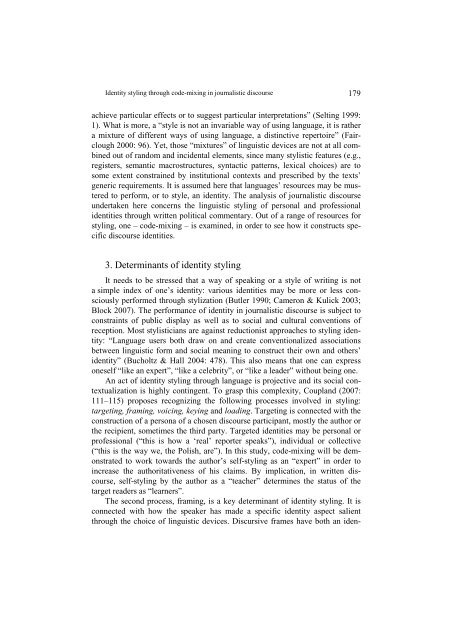s - Wyższa SzkoÅa Filologiczna we WrocÅawiu
s - Wyższa SzkoÅa Filologiczna we WrocÅawiu
s - Wyższa SzkoÅa Filologiczna we WrocÅawiu
Create successful ePaper yourself
Turn your PDF publications into a flip-book with our unique Google optimized e-Paper software.
Identity styling through code-mixing in journalistic discourse 179<br />
achieve particular effects or to suggest particular interpretations” (Selting 1999:<br />
1). What is more, a “style is not an invariable way of using language, it is rather<br />
a mixture of different ways of using language, a distinctive repertoire” (Fairclough<br />
2000: 96). Yet, those “mixtures” of linguistic devices are not at all combined<br />
out of random and incidental elements, since many stylistic features (e.g.,<br />
registers, semantic macrostructures, syntactic patterns, lexical choices) are to<br />
some extent constrained by institutional contexts and prescribed by the texts’<br />
generic requirements. It is assumed here that languages’ resources may be mustered<br />
to perform, or to style, an identity. The analysis of journalistic discourse<br />
undertaken here concerns the linguistic styling of personal and professional<br />
identities through written political commentary. Out of a range of resources for<br />
styling, one – code-mixing – is examined, in order to see how it constructs specific<br />
discourse identities.<br />
3. Determinants of identity styling<br />
It needs to be stressed that a way of speaking or a style of writing is not<br />
a simple index of one’s identity: various identities may be more or less consciously<br />
performed through stylization (Butler 1990; Cameron & Kulick 2003;<br />
Block 2007). The performance of identity in journalistic discourse is subject to<br />
constraints of public display as <strong>we</strong>ll as to social and cultural conventions of<br />
reception. Most stylisticians are against reductionist approaches to styling identity:<br />
“Language users both draw on and create conventionalized associations<br />
bet<strong>we</strong>en linguistic form and social meaning to construct their own and others’<br />
identity” (Bucholtz & Hall 2004: 478). This also means that one can express<br />
oneself “like an expert”, “like a celebrity”, or “like a leader” without being one.<br />
An act of identity styling through language is projective and its social contextualization<br />
is highly contingent. To grasp this complexity, Coupland (2007:<br />
111–115) proposes recognizing the following processes involved in styling:<br />
targeting, framing, voicing, keying and loading. Targeting is connected with the<br />
construction of a persona of a chosen discourse participant, mostly the author or<br />
the recipient, sometimes the third party. Targeted identities may be personal or<br />
professional (“this is how a ‘real’ reporter speaks”), individual or collective<br />
(“this is the way <strong>we</strong>, the Polish, are”). In this study, code-mixing will be demonstrated<br />
to work towards the author’s self-styling as an “expert” in order to<br />
increase the authoritativeness of his claims. By implication, in written discourse,<br />
self-styling by the author as a “teacher” determines the status of the<br />
target readers as “learners”.<br />
The second process, framing, is a key determinant of identity styling. It is<br />
connected with how the speaker has made a specific identity aspect salient<br />
through the choice of linguistic devices. Discursive frames have both an iden-
















